| Summary: This blog highlights the advantages and disadvantages of different RAID Levels, and thus helps you make an informed decision about implementing the right RAID level. It also outlines a RAID Recovery solution to recover corrupted data in a RAID implementation. |
|---|
If you want to set up RAID, then you need to know about the several RAID Levels. Also, you need to learn about the advantages and disadvantages of RAID Levels to choose a suitable RAID Level for your storage requirement.
| NOTE: If you have a basic understanding of RAID, skip the following section and jump right to the section on the advantages and disadvantages of RAID, below. |
|---|
Table of Contents
- What is RAID?
- Different RAID Levels with their Pros and Cons
- Which RAID Level is Right for You
- Conclusion
What is RAID?
Redundant Array of Independent Disks or RAID is a data storage virtualization technology in which multiple hard disks are combined together to form one or more logical units to provide redundancy, reliability, and scalability.
Data is distributed in several ways across the disks as per the RAID levels such as RAID 0, RAID 1, RAID 2, RAID 3, RAID 4, RAID 5, RAID 6, and RAID 10, etc.
|
NOTE: The distribution of the data across multiple drives is managed by Hardware and Software RAID implementations. Read more about RAID implementations. |
|---|
Each of the RAID levels serves a different purpose, as elaborated in the following sections. (Before, proceeding with understanding the pros and cons of the different RAID levels. It is important for you to know how to choose the RAID level that’s right for you.)
A primer on factors to choose the right RAID Level
- Cost-effectiveness
- Redundancy (reliability or security)
- Performance requirements (low, medium, high)
- Storage Capacity
Understanding different Raid Levels, advantages and disadvantages
|
TIP: When it comes to choosing a RAID level, there is no one-size-fits-all approach, as focusing on one factor usually comes at the expense of the other. |
|---|
RAID 0 – Striping
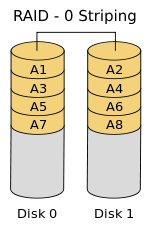
RAID 0 uses striping, which means the data in RAID Level 0 is split equally across all of the disks. Here, the storage capacity is the sum of the capacities of all the disks in the array, similar to a spanned volume. By using at least 2 disks simultaneously, it offers superior input-output performance. This performance can be enhanced further by using multiple controllers; ideally, one controller per disk.
RAID 0 does not provide redundancy or fault tolerance for handling disk failures, same as with a spanned volume. Thus, failure of one disk causes complete RAID data loss and reduces the possibility of RAID data recovery in comparison to a broken spanned volume.
|
Ideal Use: Suited for non-critical storage of data that has to be read at high speed, such as on a video/audio editing station or gaming environments. |
|---|
| Advantages and Disadvantages of RAID 0 | |
|---|---|
| Advantages | Disadvantages |
| Easy-to-implement technology | It is not fault-tolerant. A single drive failure results in complete data loss. |
| Complete utilization of storage capacity | Not an ideal choice for mission critical systems |
| Good performance in both read and write operations | |
RAID 1– Mirroring
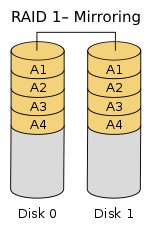
RAID Level 1 uses mirroring with no parity, striping, or spanning of disk space across multiple disks.
It is a setup of at least two drives that contain an exact copy or mirror of data. This means that all the data is redundant, by writing it on the data disk and on the mirror disk. This array is useful when read performance is important as compared to write performance. Moreover, it will continue to operate as long as one disk is in an operational state. If a drive fails, then the controller uses either the data disk or the mirror disk for data accessibility and continuity.
|
Ideal use: Critical data storage environments such as standard application servers or systems where high data redundancy, reliability (availability), and performance is needed. |
|---|
| Advantages and Disadvantages of RAID 1 | |
|---|---|
| Advantages | Disadvantages |
| It is a simple and easy to implement technology | Usable data storage capacity is only half of the total drive capacity because data is redundant. |
| Read operations are quite fast | Does not allow the swapping of the failed drive when it is hot. This means that the failed drive can be replaced only after powering down the computer to which it is connected. So, for a server that is used by many users simultaneously, this is not possible at all times. |
| Offers high fault tolerance for configurations having two disk drives | Higher cost, as RAID level 1 requires double the amount of drives to achieve the desired capacity. |
| In the case of a drive failure, data can be copied to the replacement drive thus avoiding data rebuild. | |
RAID 5 – Striping with Parity
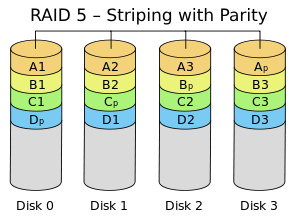
RAID Level 5 combines block-level striping with distributed parity among drives. It is the most common and secure RAID level.
RAID 5 requires a minimum of 3 drives and can work with up to a maximum of 16 drives. Data blocks are striped across the disks, and on one disk a parity checksum of all the block data is written. The parity data is not written on a fixed drive but is spread across all the drives. With this data, the computer can recalculate the data of other blocks. That means this type of array can withstand the failure of a drive without losing data. Although it can be achieved in the software, it is recommended to use a hardware controller. The extra cache memory is used on these controllers to improve the write performance. RAID level 5 combines storage with security and performance.
|
Ideal use: File storage and application servers, such as email, general storage servers, news servers, etc. |
|---|
| Advantages and Disadvantages of RAID 5 | |
|---|---|
| Advantages | Disadvantages |
| Read data transactions are fast as compared to write data transactions that are somewhat slow due to the calculation of parity. | It has a complex technology |
| Data remains accessible even after the drive failure and during replacement of the failed hard drive because the storage controller rebuilds the data on the new drive. | Failed drives have adverse effects on throughput |
| If one of the drives of large size in the array fails, replacing and restoring the data (or the rebuild time) may take one or more day, depending on the array load and speed of the controller. If another disk gets damaged or corrupt, your data gets lost forever. |
|
RAID 6 – Striping with Double Parity
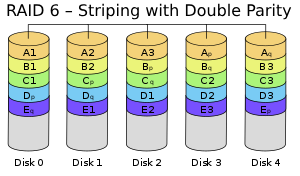
RAID Level 6 is similar to RAID 5 with an added advantage of double distributed parity, which provides fault tolerance up to 2 failed drives. It can take hours or days to rebuild this RAID array. During the rebuilding of RAID 5 if two drives fail, then data can be lost. But, in RAID 6, the RAID array will survive even after the second drive failure, thereby making RAID 6 more secure than RAID 5.
|
Ideal Use: Office automation, online customer service, and applications that require very high availability. Also, RAID 6 can be used for applications with high read request rates, but lower write requests. |
|---|
| Advantages and Disadvantages of RAID 6 | |
|---|---|
| Advantages | Disadvantages |
| Read data transactions are very fast | Due to double parity write data transactions are slow. |
| Data accessibility is high | Rebuilding RAID array takes longer time because of its complex structure. |
| Higher redundancy compared to RAID 5 | |
RAID 10 (RAID 1+0) – Mirroring and Striping
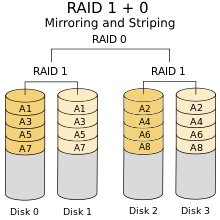
RAID Level 10 is a combination of RAID 0 and RAID 1.
That means mirroring and striping are done in one single RAID array. RAID 10 is a nested or hybrid and is sometimes identified as RAID 1 + 0. It provides both security and performance by mirroring and striping data into multiple drives. It requires minimum of 4 drives to build a RAID Level 10 or (RAID 1+ 0) system.
|
Ideal Use: This RAID level is ideal for environments – that require high performance and high data security – such as transactional databases with sensitive information |
|---|
| Advantages and Disadvantages of RAID 10 | |
|---|---|
| Advantages | Disadvantages |
| Combination of mirroring and striping makes it fast and resilient. | It is expensive |
| Mirroring makes RAID 10 secure | Limited scalability |
RAID 50 (RAID 5+0) – Block-level Striping and Distributed Parity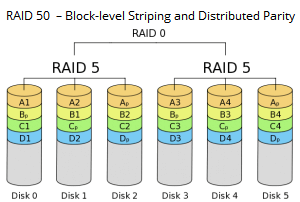
RAID Level 50 combines RAID 5 and RAID 0. That means the parity distribution and striping are visible in one single RAID array. RAID 50 is a nested or hybrid RAID and is sometimes referred to as RAID 5 + 0.
Configuring RAID 50 requires a minimum of 6 drives. It provides better write performance and security, including faster rebuild time than RAID 5 in case of a disk failure. Further, this RAID level offers increased capacity and performance by striping data into multiple drives.
Additional Reading: How to recover data from Raid 5?
|
Ideal Use: Recommended for applications that require high reliability, high capacity and high data transfer rates such as Transaction Processing applications, Office applications, etc. |
|---|
| Advantages and Disadvantages of RAID 50 | |
|---|---|
| Advantages | Disadvantages |
| Provides excellent read performance | Failure of two drives in a RAID 5 configuration renders the whole RAID 50 array as unusable |
| Increased protection without the cost overheads than a RAID 10 array | A RAID 50 array requires synchronized disks for maximum throughput, which limits disk choices. |
| Enhanced data throughput and redundancy | |
RAID 60 (RAID 6+0) – Block-level Striping and Dual Parity
RAID 60 is another type of nested or hybrid RAID that combines block-striping of RAID level 0 with dual parity of RAID level 6. It is similar to RAID 50 but offers better data reliability with less performance. This RAID level also supports larger volumes.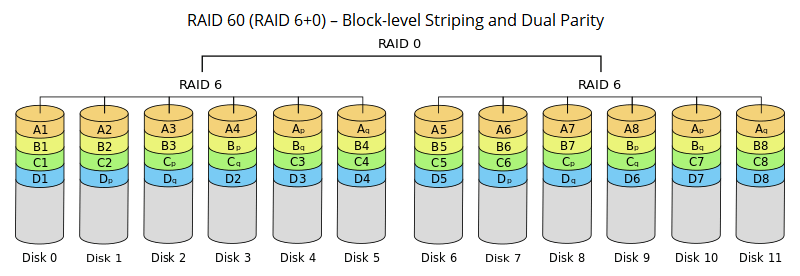
Sometimes referred to as RAID 6 + 0, RAID 60 implementation requires a minimum of 8 disks (or a 4 disk set of RAID 6) to operate.
|
Ideal Use: Suited for financial and accounting applications, database servers |
|---|
| Advantages and Disadvantages of RAID 60 | |
|---|---|
| Advantages | Disadvantages |
| High read data transaction rate | Disk space consumption is high |
| High redundancy | Slightly lower performance compared to RAID 50 |
|
NOTE: If you’re considering implementing RAID 60, keep in mind, that it consumes 50% of your storage space in overhead. However, by using RAID 10, you can achieve similar read performance and better overall write performance and levels of redundancy. |
|---|
A Comparison Chart to help you decide which RAID Level is Right for You
| Advantages and Disadvantages of RAID 60 | |||||||
|---|---|---|---|---|---|---|---|
| RAID LEVELS | RAID 0 | RAID 1 | RAID 5 | RAID 6 | RAID 10 | RAID 50 | RAID 60 |
| Description | Striping | Mirroring | Striping with Parity | Striping with double Parity | Mirroring and Striping | Striping and Distributed Parity | Striping and Dual Parity |
| Minimum Drives | 2 | 2 | 3 | 4 | 4 | 6 | 8 |
| Read Performance | High | High | High | High | High | High | High |
| Write Performance | High | Medium | High | High | Medium | Medium | Medium |
| Cost | Low | High | Low | Low | High | Medium | High |
| Data Protection | No | Yes | Yes | Yes | Yes | Yes | Yes |
| Capacity Utilization | 1 | 0.5 | 67%-94% | 50%-80% | 0.5 | 67%-94% | 50%-88% |
| Typical Applications | Live streaming, video editing | OS, transaction databases | Data warehousing | Financial and accounting applications, database servers | Fast databases, application servers | Large databases, file and application servers | Servers with large capacity requirements |
Additional Reading: Raid Server Recovery – What to Do If Your RAID Server Crashes?
EndNote
Even though RAID levels provide data redundancy. But it is not a good choice to backup your critical data. That’s because while most RAID configurations protect you against hardware failure, they do not protect you against data corruption or malicious activity.
To avoid data loss, make sure to create a backup of your critical data on a separate hard drive. If you still encounter a data loss situation due to the failure of a RAID disk drive, then use the RAID data recovery services offered by Stellar Data Recovery. You can avail of Stellar Remote data recovery services for all logical data loss cases. Our professional will check your Raid drive remotely. Then our Raid Recovery experts will provide you further processes.

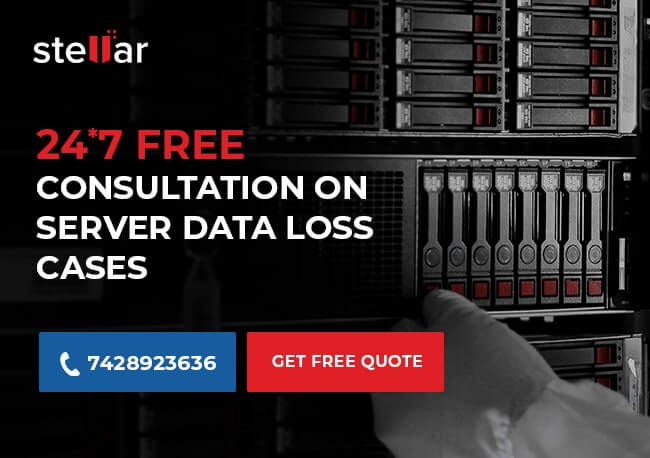

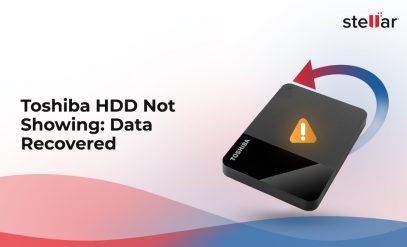
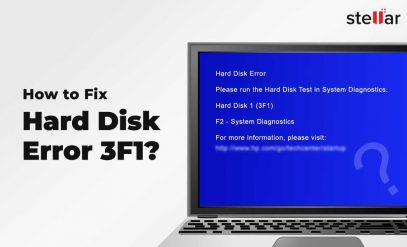




I wanted to say thank you for this great read!! I definitely enjoying every little touch of it I have
bookmarked the site to look at the new stuff of your post.
Thank You, Darrell !!
Good info. Blessed me I reach on your site by accident,
I bookmarked it.
Thanks for appreciating our efforts.
Thank you for the great post. What is the software-based controller? does it use teh same interface as the hardware controller and what are its advantages? Are there specific controllers that work best with the software driver, instead of using the embedded software?
Thanks
Amos
Hello Amos,
Software controller is used for intense computing and applications that log, manipulate and exchange large amounts of data between two entities.
Can you please elaborate your query so that we would understand what you want exactly?
It works really well for me !!
We appreciate your feedback. Keep visiting our blog for more updates.
It works very well for me
Thank you for finding our blog useful. Keep visiting our blog for more updates !!
It works quite well for me.
I spent a great deal of time to find something such as this.
Thank you for your feedback!